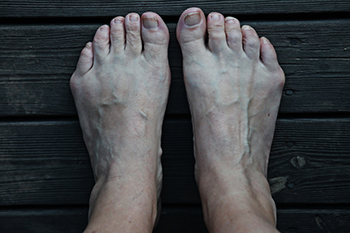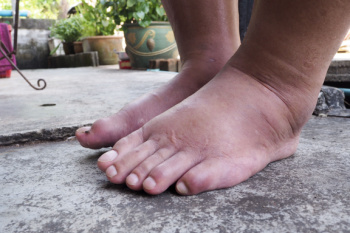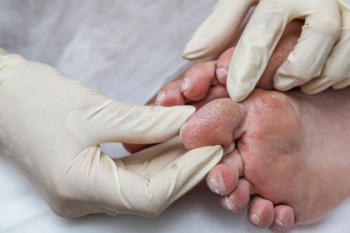Connect With Us
Blog
Items filtered by date: September 2025
What You Need to Know About a Tailors Bunion

A tailor’s bunion, also known as a bunionette, is a painful bump that forms on the outside of the foot at the base of the little toe. It may appear red, swollen, or callused and often becomes irritated by tight or narrow shoes. The condition can feel sore or sharp when walking or wearing certain shoes. Causes include inherited foot structure, pressure from ill-fitting shoes, or abnormal foot mechanics. Symptoms may worsen over time if left untreated. A podiatrist can diagnose a tailor's bunion through a physical exam and imaging, such as X-rays, to assess the alignment of the toe and surrounding joints. Conservative treatment options include shoe modifications, padding, and orthotics to reduce pressure. Anti-inflammatory medications may be prescribed for pain relief. In more severe cases, surgery may be recommended to realign the toe and remove the bony prominence. It is suggested that you make an appointment with a podiatrist for proper diagnosis and personalized treatment.
If you are suffering from bunion pain, contact one of our podiatrists of Crystal Lake Foot & Ankle Center. Our doctors can provide the care you need to keep you pain-free and on your feet.
What Is a Bunion?
Bunions are painful bony bumps that usually develop on the inside of the foot at the joint of the big toe. As the deformity increases over time, it may become painful to walk and wear shoes. Women are more likely to exacerbate existing bunions since they often wear tight, narrow shoes that shift their toes together. Bunion pain can be relieved by wearing wider shoes with enough room for the toes.
Causes
- Genetics – some people inherit feet that are more prone to bunion development
- Inflammatory Conditions - rheumatoid arthritis and polio may cause bunion development
Symptoms
- Redness and inflammation
- Pain and tenderness
- Callus or corns on the bump
- Restricted motion in the big toe
In order to diagnose your bunion, your podiatrist may ask about your medical history, symptoms, and general health. Your doctor might also order an x-ray to take a closer look at your feet. Nonsurgical treatment options include orthotics, padding, icing, changes in footwear, and medication. If nonsurgical treatments don’t alleviate your bunion pain, surgery may be necessary.
If you have any questions, please feel free to contact our office located in Crystal Lake, IL . We offer the newest diagnostic and treatment technologies for all your foot care needs.
The ABI Test
 There are several screening measures that a podiatrist might use to assess the blood flow in your lower limbs. One such measure is the Ankle-Brachial Index, also known as the ABI test, Segmental Pressure Test, Toe Pressure Test, or Toe-Brachial Index (TBI). To perform this test, the podiatrist will place an inflatable cuff around your arm and calf, foot, or toes and measure your blood pressure in these areas. The doctor will then compare the numbers to each other to determine whether you are at an increased risk of having poor circulation and developing conditions such as peripheral artery disease. This test is fast, simple, noninvasive, and generally painless. To learn more about screening measures that assess the vascular health of your lower limbs, speak with a podiatrist today.
There are several screening measures that a podiatrist might use to assess the blood flow in your lower limbs. One such measure is the Ankle-Brachial Index, also known as the ABI test, Segmental Pressure Test, Toe Pressure Test, or Toe-Brachial Index (TBI). To perform this test, the podiatrist will place an inflatable cuff around your arm and calf, foot, or toes and measure your blood pressure in these areas. The doctor will then compare the numbers to each other to determine whether you are at an increased risk of having poor circulation and developing conditions such as peripheral artery disease. This test is fast, simple, noninvasive, and generally painless. To learn more about screening measures that assess the vascular health of your lower limbs, speak with a podiatrist today.
Vascular testing plays an important part in diagnosing disease like peripheral artery disease. If you have symptoms of peripheral artery disease, or diabetes, consult with one of our podiatrists from Crystal Lake Foot & Ankle Center. Our doctors will assess your condition and provide you with quality foot and ankle treatment.
What Is Vascular Testing?
Vascular testing checks for how well blood circulation is in the veins and arteries. This is most often done to determine and treat a patient for peripheral artery disease (PAD), stroke, and aneurysms. Podiatrists utilize vascular testing when a patient has symptoms of PAD or if they believe they might. If a patient has diabetes, a podiatrist may determine a vascular test to be prudent to check for poor blood circulation.
How Is it Conducted?
Most forms of vascular testing are non-invasive. Podiatrists will first conduct a visual inspection for any wounds, discoloration, and any abnormal signs prior to a vascular test.
The most common tests include:
- Ankle-Brachial Index (ABI) examination
- Doppler examination
- Pedal pulses
These tests are safe, painless, and easy to do. Once finished, the podiatrist can then provide a diagnosis and the best course for treatment.
If you have any questions please contact our office located in Crystal Lake, IL . We offer the newest diagnostic and treatment technologies for all your foot and ankle needs.
Treatment Options for Clubfoot

Clubfoot is a congenital condition that causes a baby’s foot to turn inward or downward, affecting one or both feet. The heel and calf on the affected side are often smaller, and, in severe cases, the foot may appear twisted and almost upside down. Although clubfoot is not painful for babies, it prevents normal walking, if left untreated. Genetics appears to play a role in this condition, as risk increases when there is a family history. Other contributing factors include smoking during pregnancy or reduced amniotic fluid in the womb. A podiatrist can diagnose clubfoot soon after birth, and, in some cases, it may even be detected on prenatal imaging. Treatment often begins within weeks of delivery. It may involve gentle stretching with casting and a gradual repositioning of the foot. Surgery is considered when the deformity is severe. If your baby has a clubfoot deformity, it is suggested that you promptly schedule an appointment with a podiatrist, including this type of doctor on your healthcare team.
Congenital foot problems require immediate attention to avoid future complications. If you have any concerns, contact one of our podiatrists of Crystal Lake Foot & Ankle Center. Our doctors can provide the care you need to keep you pain-free and on your feet.
Congenital foot problems are deformities affecting the feet, toes, and/or ankles that children are born with. Some of these conditions have a genetic cause while others just happen. Some specific foot ailments that children may be born with include clubfeet, polydactyly/macrodactyly, and cleft foot. There are several other foot anomalies that can occur congenitally. What all of these conditions have in common is that a child may experience difficulty walking or performing everyday activities, as well as trouble finding footwear that fits their foot deformity. Some of these conditions are more serious than others. Consulting with a podiatrist as early as possible will help in properly diagnosing a child’s foot condition while getting the necessary treatment underway.
What are Causes of Congenital Foot Problem?
A congenital foot problem is one that happens to a child at birth. These conditions can be caused by a genetic predisposition, developmental or positional abnormalities during gestation, or with no known cause.
What are Symptoms of Congenital Foot Problems?
Symptoms vary by the congenital condition. Symptoms may consist of the following:
- Clubfoot, where tendons are shortened, bones are shaped differently, and the Achilles tendon is tight, causing the foot to point in and down. It is also possible for the soles of the feet to face each other.
- Polydactyly, which usually consists of a nubbin or small lump of tissue without a bone, a toe that is partially formed but has no joints, or an extra toe.
- Vertical talus, where the talus bone forms in the wrong position causing other bones in the foot to line up improperly, the front of the foot to point up, and the bottom of the foot to stiffen, with no arch, and to curve out.
- Tarsal coalition, when there is an abnormal connection of two or more bones in the foot leading to severe, rigid flatfoot.
- Cleft foot, where there are missing toes, a V-shaped cleft, and other anatomical differences.
- Macrodactyly, when the toes are abnormally large due to overgrowth of the underlying bone or soft tissue.
Treatment and Prevention
While there is nothing one can do to prevent congenital foot problems, raising awareness and receiving neonatal screenings are important. Early detection by taking your child to a podiatrist leads to the best outcome possible.
If you have any questions, please feel free to contact our office located in Crystal Lake, IL . We offer the newest diagnostic and treatment technologies for all your foot care needs.
Understanding Swollen Feet and Ankles

Swollen feet and ankles can be uncomfortable and may signal underlying health concerns. Common causes include poor circulation, sprains, injuries, cardiac insufficiency, and pregnancy. The swelling often results from fluid buildup in the tissues, making movement difficult and sometimes painful. While occasional swelling may improve with rest and elevation, persistent or severe swelling should not be ignored. A podiatrist can help identify the root cause, whether it is related to injury, circulation, or another condition, and create a treatment plan to relieve discomfort and protect your overall health. If you are struggling with swollen feet or ankles, it is suggested that you consult a podiatrist who can accurately diagnose and offer effective relief and treatment solutions.
Swollen feet can be a sign of an underlying condition. If you have any concerns, contact one of our podiatrists of Crystal Lake Foot & Ankle Center. Our doctors can provide the care you need to keep you pain-free and on your feet.
Swollen feet are a common ailment among pregnant women and people who stand or sit for extended periods. Aging may increase the possibility of swollen feet and patients who are obese often notice when their feet are swelling too. There may be medical reasons why swollen feet occur:
- Phlebitis - A condition that causes the veins to become inflamed and can also cause leg pain.
- Liver disease - This may lead to low blood levels of albumin which is a protein. This can cause fluid in the blood to pass into the tissues and several areas of the body can become swollen.
- Heart failure - When the heart doesn’t pump properly the blood that is normally pumped back to the heart can pool in the veins of the legs causing swollen feet.
- Kidney disease - One of the main functions of the kidneys is releasing excess fluid in the body. This type of condition can make it difficult for the kidneys to function properly, and as a result the feet may become swollen.
- Deep-vein thrombosis (DVT)- This is a serious condition where blood clots form in the veins of the legs. They can block the return of blood from the legs to the heart which may cause the feet to swell. It is important to be treated by a podiatrist if this condition is present.
Swollen feet can also be caused by bone and tendon conditions, including fractures, arthritis, and tendinitis. Additionally, there may be skin and toenail conditions and an infection may cause the feet to swell. Patients who take medicine to treat high blood pressure may be prone to getting swollen feet.
Many patients elevate their feet to help relieve the swelling and this is generally a temporary remedy. When a podiatrist is consulted the reason behind the swelling can be uncovered and subsequently treated.
If you have any questions please contact our office located in Crystal Lake, IL . We offer the newest diagnostic and treatment technologies for all your foot and ankle needs.
Ankle Fracture? Don’t Wait for Treatment
How Diabetes Can Affect the Feet

Diabetes can have a serious impact on the feet, as high blood sugar damages both the nerves and blood vessels in the lower limbs. Nerve damage, known as diabetic neuropathy, often leads to tingling, burning, or numbness, and eventually a loss of sensation. Without sensation in the feet, a person may not notice minor injuries or pressure from shoes that lack adequate support, which can progress into ulcers, deformities, or infections. Poor circulation, commonly linked with peripheral arterial disease, further slows healing and increases the chance of more serious complications. Infections in the diabetic foot can be difficult to detect, which raises the risk of limb loss if untreated. A podiatrist can carefully examine the feet, detect early signs of neuropathy, monitor circulation, and provide specialized care to prevent ulcers, and infections. If you have foot problems related to diabetes, it is suggested that you make regular visits with a podiatrist for help in managing this condition.
Diabetic foot care is important in preventing foot ailments such as ulcers. If you are suffering from diabetes or have any other concerns about your feet, contact one of our podiatrists from Crystal Lake Foot & Ankle Center. Our doctors can provide the care you need to keep you pain-free and on your feet.
Diabetic Foot Care
Diabetes affects millions of people every year. The condition can damage blood vessels in many parts of the body, especially the feet. Because of this, taking care of your feet is essential if you have diabetes, and having a podiatrist help monitor your foot health is highly recommended.
The Importance of Caring for Your Feet
- Routinely inspect your feet for bruises or sores.
- Wear socks that fit your feet comfortably.
- Wear comfortable shoes that provide adequate support.
Patients with diabetes should have their doctor monitor their blood levels, as blood sugar levels play such a huge role in diabetic care. Monitoring these levels on a regular basis is highly advised.
It is always best to inform your healthcare professional of any concerns you may have regarding your feet, especially for diabetic patients. Early treatment and routine foot examinations are keys to maintaining proper health, especially because severe complications can arise if proper treatment is not applied.
If you have any questions, please feel free to contact our office located in Crystal Lake, IL . We offer the newest diagnostic and treatment technologies for all your foot care needs.

